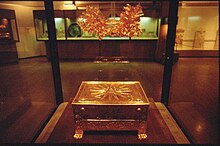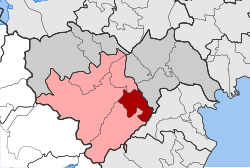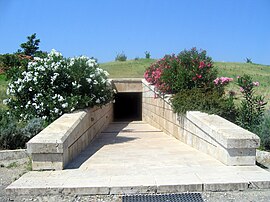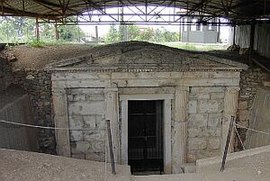Vergina
|
Vergina parish Δημοτική Ενότητα Βεργίνας (Βεργίνα) |
||
|---|---|---|
|
|
||
| Basic data | ||
| State : |
|
|
| Region : |
Central Macedonia
|
|
| Regional District : | Imathia | |
| Municipality : | Veria | |
| Geographic coordinates : | 40 ° 29 ′ N , 22 ° 19 ′ E | |
| Height above d. M .: | 60 - 120 - 340 m above sea level Prodromou - Vergina - Sykia |
|
| Area : | 68.847 km² | |
| Residents : | 2,464 (2011) | |
| Population density : | 35.8 inhabitants / km² | |
| Code No .: | 080103 | |
| Structure: | 4 local communities | |
| Located in the municipality of Veria and in the Imathia regional unit | ||
Vergina ( Greek Βεργίνα [ vɛrˈʝina ] ( f. Sg. ), Bulgarian / Macedonian Кутлеш or Kutleš ) is a northern Greek place in the municipality of Veria in the Central Macedonia region .
In 1934 the rural community (kinotita) Vergina was formed by outsourcing from Palatitsia. In 1997, some neighboring communities were incorporated into Vergina and the community was raised to a township (dimos) . With the administrative reform in 2010 , Vergina became part of the municipality of Veria , where it forms one of five municipal districts.
The excavation site at Vergina is probably identical to the ancient city of Aigai , which dates back to 410 BC. Chr. Capital of the kingdom of Macedonia was. Even later, the place served as a burial place for the Macedonian kings. At Vergina there is also an Iron Age burial mound necropolis with around 300 graves from the 11th - 9th centuries BC. BC, to which a so far not clearly identified settlement was assigned. The Vergina archaeological site has been a UNESCO World Heritage Site since 1996 .
For the structure of Vergina in localities and settlements see Veria # Verwaltungsgliederung .
Archaeological dig site
antique City
The ancient city near Vergina probably extended mainly north of the palace complex. Several sanctuaries and a theater belonged to the city, which was built in the 2nd half of the 4th century BC. Has been built. The city appears in the 1st half of the 2nd century BC. To have been badly destroyed.
palace
The remains of the palace lie on the slopes of the Pieria Mountains. The building measures 104.5 × 88.5 m and has a square inner courtyard with a side length of 44.5 m, which was bordered by a colonnade . Rooms of different sizes were connected to the colonnade. In addition, the palace, which was probably two-story on the east side, had a terrace that opened onto the Aliakmonas valley. The palace is dated to the third quarter of the 4th century BC. BC and was possibly even before the conquest of Macedonia by the Romans in 168 BC. Chr. Destroyed.
Graves from Macedonian times
In the area around Vergina there are nine chamber tombs from Macedonian times. Four graves lie under a large tumulus with a diameter of 110 m at the time and a height of over 12 m. Three graves are richly painted and provided with many grave goods, the fourth was badly destroyed and robbed.

The largest grave in the large tumulus is the so-called Philipp grave. It is divided into an antechamber and a main chamber and has a facade with Ionic columns , pilasters and a colorfully painted frieze . The grave goods of Philip's grave are very extensive. Both the antechamber and the main chamber contained a golden larnax , which was decorated with a star, the so-called star of Vergina . The larnax in the main chamber contained a golden oak wreath and, formerly wrapped in a purple cloth , the burned bones of a man. The bones are attributed to Philip II , father of Alexander the Great . When examining the skeletal remains, the British anthropologist Jonathan H. Musgrave found a healed bone wound in the right eye. Since it is said that Philip II. His right eye at the Battle of Methone in 355/4 BC. BC lost, this finding explains the affiliation of the Macedonian king to this tomb. However, this connection is not considered to be certain. Others point out that with the dating of the tomb itself, Philip III. Arrhidaios (352–317 BC), half-brother and successor to Alexander the Great, as the grave owner is likely.

In addition to the Philip's grave, the prince's and Persephone's graves can be found in the large tumulus . The Romaios and Eurydice graves are north of the palace. Four other chamber graves were located west of the village of Palatitsa .
The graves provide important cultural and historical references to the self-portrayal of the Macedonian royal dynasty of the Argeadians . Contrary to the often held opinion that Macedonia lies outside the Greek cultural area, the royal family presents itself in the tombs as Greeks: grave goods show hunting and war scenes as well as symposia as part of the king's Greek life; Weapons and even utensils such as wine mixers (which should prove that the Macedonian dynasty like the Greeks did not drink wine pure) are to be seen as reminiscences of classical Greece, cremation and burial of the ashes of the models of the Homeric epics.
Excavation history
The excavation of the Hellenistic sites began in 1861 under the French archaeologist Léon Heuzey and continues to this day. In 1977 Manolis Andronikos discovered the richly decorated graves under the large tumulus, untouched by grave robbers .
museum
The burial mound with the so-called Philip's grave and other graves has now been integrated into an underground museum building, which also presents the numerous grave goods.
exhibition
In 2011 the exhibition Heracles to Alexander: Treasures from the Royal Capital of Macedonia took place at the Ashmolean Museum in Oxford . A Hellenic Kingdom in the Age of Democracy . For the first time outside of Greece, the treasures found in the palaces and tombs in Aigai over the past decades were exhibited.
literature
- Manolis Andronikos : Vergina. The Royal Tombs and the Ancient City. Ekdotike Athenon, Athens 1984.
- Gustav Hirschfeld : Aigai 3 . In: Paulys Realencyclopadie der classischen Antiquity Science (RE). Volume I, 1, Stuttgart 1893, Col. 944.
- Julia Vokotopoulou: Guide to the Archaeological Museum of Thessaloniki. Editions Kapon, Athens 1996, ISBN 960-7254-35-X , pp. 149–178
- Ioannis Touratsoglou : Macedonia - History, Monuments and Museums. Ekdotike Athenon, Athens, ISBN 960-213-329-5 , 1995, 1997.
Individual evidence
- ↑ Results of the 2011 census at the National Statistical Service of Greece (ΕΛ.ΣΤΑΤ) ( Memento from June 27, 2015 in the Internet Archive ) (Excel document, 2.6 MB)
Web links
- Entry on the UNESCO World Heritage Center website ( English and French ).
- Hellenic Ministry of Culture: Vergina-Aigai (English)
- Vergina: Golden Larnax





